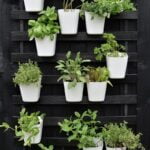Are you looking to elevate the curb appeal of your home with a stunning front yard landscape? Whether you’re a gardening enthusiast or a novice, understanding the importance of plant spacing is crucial in creating a visually appealing and thriving outdoor space. In this article, we will explore front yard landscaping ideas and provide a comprehensive plant spacing guide to help you achieve the perfect balance between form and function.
Creating a cohesive and visually appealing landscape for your front yard involves more than just choosing beautiful plants. It requires careful consideration of their placement and spacing to ensure optimal growth and aesthetics. By following the tips and guidelines in this article, you can design a front yard that not only enhances the beauty of your home but also reflects your personal style and preferences.
Explore different types of plants and their ideal spacing requirements as we delve into choosing the right plants for your front yard landscape. We will also discuss the various factors to consider, such as sunlight exposure, soil type, and climate, that can impact plant spacing decisions.
Additionally, you will find step-by-step guidance on how to measure and space plants for optimal growth as well as expert advice from professional landscapers on maximizing plant spacing for a stunning display. So whether you’re starting from scratch or looking to refresh your existing front yard landscape, this article has got you covered.
Designing Your Front Yard
When designing your front yard, it’s important to consider the overall aesthetic you want to achieve. A cohesive and visually appealing landscape can greatly enhance the curb appeal of your home. Here are some tips to help you create a stunning front yard:
1. Plan the layout: Before diving into any planting, take the time to plan out the layout of your front yard. Consider factors such as walkways, focal points, and any existing structures that you want to incorporate into your landscaping design.
2. Choose a color scheme: A well-thought-out color scheme can tie everything together in your front yard. Whether you prefer a harmonious monochromatic scheme or a vibrant mix of colors, make sure the plants you choose complement each other.
3. Create layers: To add depth and visual interest to your front yard, incorporate different layers of plants. Consider using taller shrubs or trees in the back for height, mid-sized plants in the middle for fullness, and low-growing ground cover at the front for added texture.
4. Incorporate hardscaping elements: In addition to plants, don’t forget to include hardscaping elements such as rocks, pavers, or sculptures in your front yard design. These elements can add structure and balance to your landscape.
Remember that all these aspects should be considered along with plant spacing guide when designing your front yard landscape.
Overall, creating a cohesive and visually appealing landscape for your front yard requires careful planning and attention to detail. By incorporating these tips into your design process, you can create a beautiful outdoor space that will make a lasting impression on visitors and passersby alike.
Choosing the Right Plants
Understanding Plant Types
When it comes to front yard landscaping, one of the key aspects to consider is the type of plants that will be used. There are various options to choose from, including flowers, shrubs, trees, and grasses. Each type of plant has its own unique characteristics and requirements for growth, which directly impacts the spacing needed for optimal development.
Ideal Spacing Requirements
Different types of plants have different ideal spacing requirements based on their size and growth habits. For example, small flowers or ground cover plants may only need a few inches of space between them, while larger shrubs or trees may require several feet of distance for healthy growth. Understanding the specific spacing needs of each plant type is crucial in ensuring that they have enough room to thrive and reach their full potential.
Customizing Your Landscape
In addition to understanding the ideal spacing requirements for different types of plants, it’s important to consider how these plants will complement each other within your landscape design. Mixing various plant types with differing space requirements can create a visually appealing and dynamic front yard. Taking into account color, texture, and height when choosing plants and determining their spacing will help create a cohesive and balanced overall look for your landscape.
By carefully selecting a variety of plant types with consideration for their individual spacing needs, you can create a diverse and visually stunning front yard landscape that will flourish for years to come. Whether you’re interested in creating an English garden filled with colorful blooms or a modern desert landscape with native succulents, understanding the ideal spacing requirements for different plant types is essential in achieving your desired aesthetic.
Factors to Consider
The health and growth of your front yard landscape plants heavily depend on several factors, including sunlight, soil type, and climate. Understanding how these elements impact plant spacing is crucial to creating a thriving and visually appealing outdoor space.
When it comes to sunlight, different plants have varying needs. Some thrive in full sun, while others require partial shade or full shade. Before planting, take note of the sun exposure in your front yard throughout the day. This will help you determine the ideal placement for each type of plant to ensure they receive the right amount of sunlight for healthy growth.
Soil type also plays a significant role in plant spacing. Some plants prefer well-drained soil, while others can tolerate clay or sandy soil. Before selecting and placing your plants, consider conducting a soil test to determine its composition and pH levels. This information will guide you in choosing the right plants for your specific soil type and in allocating proper spacing between them for optimal nutrient absorption.
Additionally, the climate in your region should be considered when planning plant spacing in your front yard landscaping. Plants that are native to your area are more likely to thrive compared to non-native species. Take into account temperature fluctuations, precipitation levels, and any extreme weather conditions that may affect the growth of your plants.
| Factors to Consider | Ideas |
|---|---|
| Sunlight | Take note of sun exposure throughout the day to place plants accordingly |
| Soil Type | Conduct a soil test to determine composition and pH levels for accurate plant selection |
| Climate | Consider temperature fluctuations and precipitation levels when choosing native plants |
Implementing Plant Spacing
Assess Your Space
Before you start planting, it is essential to assess your front yard space and take note of any existing structures or features. Consider the layout of your garden beds, pathways, and any potential obstacles that may affect plant placement. By understanding the available space and its limitations, you can strategically plan where to place your plants for maximum visual impact.
Follow Plant-Specific Guidelines
Different plants have varying spacing requirements based on their size and growth habits. When selecting and arranging your greenery, refer to specific guidelines provided for each type of plant. For example, larger shrubs or trees may need more distance between them to allow for proper root development and prevent overcrowding. On the other hand, smaller perennials or ground cover plants can be placed closer together to create a lush, full look.
Utilize Measuring Tools
To ensure accuracy in plant spacing, utilize measuring tools such as a tape measure or ruler. When planting in rows or patterns, consistent spacing is essential for creating a cohesive look. Measure the distance between each plant according to their specific requirements and mark the spots where they will be planted. This will help you maintain uniformity throughout your front yard landscape while promoting optimal growth for each individual plant.
By following these steps for implementing plant spacing in your front yard landscaping project, you can create a visually appealing and healthy outdoor environment that complements your home’s exterior. Taking the time to measure and space your plants correctly will ultimately result in a stunning display of greenery that enhances the curb appeal of your property.
Now that you have an understanding of how to implement proper plant spacing, you are well on your way to bringing your front yard landscaping ideas to fruition with confidence and precision.
Maintenance and Care
When it comes to maintaining the health and beauty of your front yard landscape, proper plant spacing is key. Without adequate space between plants, they may end up competing for resources such as sunlight, water, and nutrients, leading to stunted growth and an unattractive garden. In this section, we will explore some essential tips for preserving the health and beauty of your front yard landscape through effective maintenance and care.
One important aspect of maintaining a well-spaced front yard landscape is regular pruning. By trimming back overgrown branches and foliage, you can prevent overcrowding and ensure that each plant has enough space to thrive. Additionally, pruning encourages proper air circulation within the garden, reducing the risk of diseases and promoting overall plant health.
Another crucial factor in caring for your front yard landscape is irrigation. Different types of plants have varying water requirements, so it’s important to tailor your watering schedule to meet their needs. Proper watering not only helps maintain the health of individual plants but also contributes to the overall aesthetic appeal of your landscape.
In addition to pruning and irrigation, regular weeding is essential for preserving the beauty of your front yard landscape. Weeds not only compete with your ornamental plants for resources but can also detract from the visual impact of your garden. By staying on top of weed control, you can ensure that your carefully spaced plants remain the focal point of your front yard landscaping design.
| Maintenance Tips | Benefits |
|---|---|
| Regular pruning | Prevents overcrowding and promotes air circulation |
| Proper watering | Maintains plant health and enhances aesthetic appeal |
| Regular weeding | Prevents weeds from competing with ornamental plants and maintains visual impact |
Creative Planting Ideas
When it comes to front yard landscaping, the creative arrangement of plants can make all the difference in creating a visually stunning outdoor space. By thinking outside the box and incorporating unique planting ideas, you can truly elevate the look of your front yard. Here are some creative planting ideas to inspire you:
- Vertical Gardens: Utilize vertical space by incorporating hanging planters, trellises, or wall-mounted containers to create a lush and eye-catching display.
- Succulent Gardens: Create a low-maintenance and modern look by designing a succulent garden with an array of shapes, sizes, and textures.
- Colorful Borders: Plant colorful flowers or foliage along the borders of your front yard to add a pop of color and visual interest.
In addition to these ideas, consider incorporating elements such as decorative pots, ornamental grasses, or even unexpected items like driftwood or antique garden tools to add a touch of personality to your landscape. By experimenting with different plant combinations and arrangements, you can create a front yard that stands out from the rest.
Ultimately, don’t be afraid to showcase your creativity and personality through your front yard landscaping. Whether you opt for a whimsical cottage garden or a sleek modern design, think outside the box and have fun with your planting ideas. With careful consideration of plant spacing and ideal placements based on sunlight and soil conditions, you can create a truly unique and eye-catching front yard display that reflects your personal style and taste.
Expert Advice
In conclusion, achieving a stunning front yard display through effective plant spacing is not only about aesthetics but also about preserving the health and vitality of your landscape. By understanding the importance of plant spacing, designing with cohesion in mind, and choosing the right plants for your specific climate and soil type, you can create a visually appealing and vibrant outdoor space.
Additionally, implementing proper plant spacing and following maintenance tips will ensure that your front yard remains beautiful and thriving.
Professional landscapers provide valuable insights into maximizing plant spacing to create an impressive front yard landscape. Their expertise can guide you in selecting the right plants, measuring and spacing them properly, and maintaining their health over time. By seeking expert advice, you can access a wealth of knowledge that will help you design and maintain a front yard that is both visually appealing and sustainable.
Incorporating creative planting ideas can further enhance the appeal of your front yard landscape. Whether it’s experimenting with unique plant arrangements, incorporating different textures and colors, or utilizing vertical gardening techniques, there are endless possibilities to make your outdoor space stand out.
With the right guidance from landscaping professionals and some creativity on your part, you can achieve a front yard that not only looks stunning but also thrives for years to come. When implementing front yard landscaping ideas plant spacing guide it’s crucial to consider expert advice as it would greatly help maximize the effectiveness of your efforts.
Frequently Asked Questions
How Far Apart Should Plant Be in Landscape?
The distance between plants in a landscape largely depends on the specific plant species and their mature size. It’s important to consider the potential growth of each plant and provide enough space for them to thrive without becoming overcrowded.
This typically means following spacing recommendations provided on the plant’s label or consulting with a local nursery or landscaping professional.
What Is the Best Spacing Between Plants?
The best spacing between plants also varies based on the type of plant, its ultimate size, and the overall design goals for the landscape. Some plants benefit from being spaced more closely together to create a lush, full appearance, while others require more room to spread out and develop properly.
Balancing aesthetic considerations with practical needs is key when determining the ideal spacing between plants.
How Do I Organize My Front Yard Plants?
When organizing front yard plants, it’s helpful to first consider factors such as sunlight exposure, soil type, and drainage patterns. By grouping together plants that have similar needs in these areas, it becomes easier to create cohesive and visually appealing arrangements.
Additionally, incorporating varying heights, textures, colors, and blooming times can add interest and balance to the overall design of the front yard landscape.

Welcome to my gardening blog! I am passionate about plants and enjoy sharing my knowledge and experiences with others. In this blog, I will write about everything related to gardening, from tips on how to get started to updates on my own garden projects.





